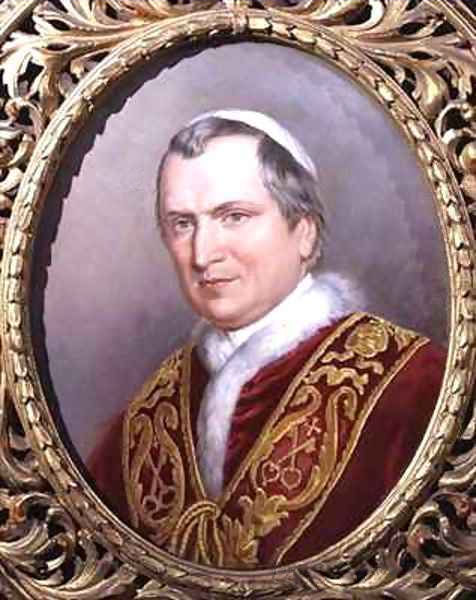Pope Blessed Pius IX
(GIOVANNI MARIA MASTAI-FERRETTI).
Portrait of Pope Pius IX, Giovanni Maria Mastai Ferretti. Painted by Theodor Breidwiser
Pope from 1846-78; born at Sinigaglia, 13 May, 1792; died in Rome, 7 February, 1878.
BEFORE HIS PAPACY
His early years. After receiving his classical education at the Piarist College in Volterra from 1802-09 he went to Rome to study philosophy and theology, but left there in 1810 on account of political disturbances. He returned in 1814 and, in deference to his father’s wish, asked to be admitted to the pope’s Noble Guard. Being subject to epileptic fits, he was refused admission and, following the desire of his mother and his own inclination, he studied theology at the Roman Seminary, 1814-18. Meanwhile his malady had ceased and he was ordained priest, 10 April, 1819. Pius VII appointed him spiritual director of the orphan asylum popularly known as “Tata Giovanni”, in Rome, and in 1823 sent him, as auditor of the Apostolic delegate, Mgr Muzi, to Chile in South America. Upon his return in 1825 he was made canon of Santa Maria in Via Lata and director of the large hospital of San Michele by Leo XII. The same pope created him Archbishop of Spoleto, 21 May, 1827. In 1831 when 4000 Italian revolutionists fled before the Austrian army and threatened to throw themselves upon Spoleto, the archbishop persuaded them to lay down their arms and disband, induced the Austrian commander to pardon them for their treason, and gave them sufficient money to reach their homes. On 17 February, 1832, Gregory XVI transferred him to the more important Diocese of Imola and, 14 December, 1840, created him cardinal priest with the titular church of Santi Pietro e Marcellino, after having reserved him since 23 December, 1839. He retained the Diocese of Imola until his elevation to the papacy. His great charity and amiability had made him beloved by the people, while his friendship with some of the revolutionists had gained for him the name of liberal.
His election. On 14 June, 1846, two weeks after the death of Gregory XVI, fifty cardinals assembled in the Quirinal for the conclave. They were divided into two factions, the conservatives, who favoured a continuance of absolutism in the temporal government of the Church, and the liberals, who were desirous of moderate political reforms. At the fourth scrutiny, 16 June, Cardinal Mastai-Ferretti, the liberal candidate, received three votes beyond the required majority. Cardinal Archbishop Gaysruck of Milan had arrived too late to make use of the right of exclusion against his election, given him by the Austrian Government. The new pope accepted the tiara with reluctance and in memory of Pius VII, his former benefactor, took the name of Pius IX. His coronation took place in the Basilica of St. Peter on 21 June. His election was greeted with joy, for his charity towards the poor. his kindheartedness, and his wit had made him very popular.
Read more here:
http://nobility.org/2013/02/07/february-7-liberal-to-anti-liberal/



No comments:
Post a Comment